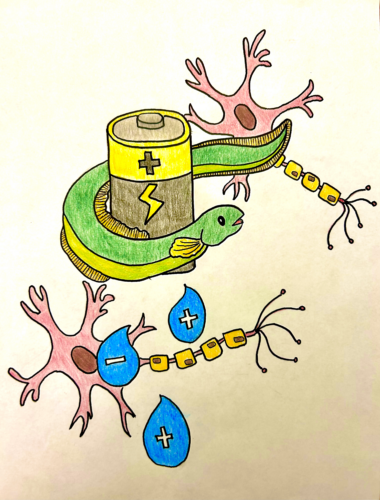Art Courtesy of Sonia Jin.
All the devices you own right now—whether it be your computer, phone, or the TV on which you watch your favorite shows—would be useless without one essential component: a battery. As technology has improved, batteries have gotten more lightweight and hidden. But while they are small enough to operate our phones and TVs, they aren’t small enough for bio-integrated devices—technology that can stimulate our cells.
When a premature baby is born, their whole body is covered in wires and sticky tape to measure temperature, blood pressure, respiratory rate, and heart rate. These wires and tape frustrate both the baby and mother, limiting their ability to interact and move. Using a bio-integrated device would allow them to avoid all this trouble, but currently, bio-integrated devices don’t have a power source that can operate at the microscopic scale and still simulate human tissue.
University of Oxford researchers Yujia Zhang and Linna Zhou from the Hagan Bayley lab group have developed a miniature battery capable of altering the activity of human nerve cells. These researchers were inspired by nature and took a cue from ocean life: their device mimics electric eels by using internal ions to generate electricity.
Electric eels have been intensely studied over the years. In fact, Zhang was inspired by a paper that studied the energy mechanism of the eels. In it, Thomas B. H. Schroeder, Anirvan Guha, and Michael Mayer developed a large-scale hydrogen power source using that same mechanism. Zhang and his team had a simple thought: “Maybe we can shrink this down via a droplet technique.”
The miniature power source they envisioned came to life using a chain of five nanoliter-sized droplets of a conductive hydrogel (a 3D network of polymer chains that contain a large quantity of absorbed water). For comparison, one strand of human hair is 80,000 to 100,000 nanometers wide.
Each droplet has a slightly different composition, which creates a salt concentration gradient. At first, the droplets are separated from their neighbors by a membrane made of lipids which prevents ions from flowing between the droplets. But when the structure is cooled, it changes the medium, and the power of the structure is activated. When the droplets on the ends of this chain are connected to electrodes, their energy is released and transformed into electricity. Electricity then enables the hydrogel structure to act as a power source for external components.
Living cells could also be attached to this device, which means that their activity would be impacted by the ionic current. When the power source is “turned on” (by cooling the structure), the neurons are able to “talk” to each other via calcium signaling.
Their five-droplet units were only the beginning. By combining twenty of these five-droplet units in series, Zhang’s team was able to illuminate a two-volt LED light. In the future, the team hopes to use a droplet printer to produce droplet networks made up of thousands of power units. With that amount of power, they can run bio-integrated devices long term.
“The major goal of this synthetic tissue project is to be able to interface with real tissues, creating a network between synthetic ones and biological ones,” Zhang said. “This [project] is only one puzzle piece of the whole puzzle.”
In this project, Zhang’s team was able to stimulate neurons, but they are already working on stimulating heart tissues in a way that allows them to create a network of synthetic and real cells. Their end goal is to have a multifunctional interface to various tissues and organs, not just an interface for neurons. Through a full-body interface, the researchers would be able to control the communication of different types of cells, which will allow scientists to study cell development and tissue regeneration.
Zhang says his team owes the majority of its success to its breadth of expertise—their research involves engineering, chemistry, and biology. “It is very important for young scientists to understand the interdisciplinary nature of experiments, ” Zhang said. “It isn’t enough to just be an expert in one field, but a lot of different fields. Only by combining these fields together can we truly solve these problems.”
In the future, their new battery could have a notable impact on devices such as bio-hybrid interfaces, microrobots, and implants for improved disease monitoring, targeted drug delivery, and more. Zhang hopes that his team’s research will make these ideas one step closer to reality.

